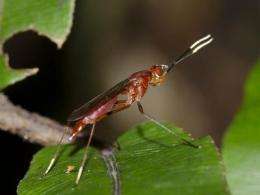Three-year insect inventory of a Costa Rican rainforest now underway

An ambitious three-year insect inventory of a Costa Rican rainforest, funded by a $900,000 National Science Foundation, is now underway. Led by Drs. Brian Brown (Natural History Museum of Los Angeles County) and Art Borkent (Royal British Columbia Museum, Canada), an international, 44-member team of fly specialists, including experts at the National Biodiversity Institute (INBio) of Costa Rica, are working to inventory all the species living in an approximately 5-acre area (100 by 200 meters). The site is located in a tropical cloud forest in the foothills in eastern Costa Rica, called Zurquí de Moravia.
The Natural History Museum of Los Angeles County (NHM) team returned from their second trip this summer, and have now established collecting and preparation protocols. They estimate they will discover at least 3,000 species, many of them new to science.
The Diptera, or true flies, are already known to include more than 160,000 species worldwide, far more than all the better known mammals, birds, fish, reptiles, and amphibians combined, and are equally susceptible to extinction and habitat loss. Research on flies is less advanced, however.
NHM's Entomology Department is currently specializing in the group, and will become a hub to dipterists everywhere. Assessing their biodiversity is one step towards understanding complex ecosystems and creating an informed conservation plan that gives us a starting point to assess ongoing climate change.
"As the first effort to comprehensively survey all species of a large, mega-diverse group of invertebrates of a tropical forest location, this is potentially a landmark research project in tropical biology" said Brown. American Museum of Natural History Curator, Dr. David Grimaldi, agreed. "This will make a very important contribution to understanding the species diversity of a highly diverse, but restricted tropical fauna. One really wonders how many species such an area holds, particularly new and endemic ones."
Determining how many species there are in a certain region is often unsuccessful because there are too many specimens collected from too many sites, and often not enough staff to prepare and identify organisms. "Most earlier attempts for complete surveys got bogged down by trying to do too much," said Brown. "Our survey is restricted to a small site that, with the help of many experts, will give us a complete list of species."
Researchers set up limited sample sites in areas of high biodiversity and enlisted large staffs to collect, prepare, and identify flies. "Previous research has shown that middle elevation sites, like this one, are the most diverse in the world," said Brown.
"We wanted the site that had the most potential for high diversity and number of species new to science," Dr. Borkent added. "No one really knows how many species are actually present in a single location, anywhere in the tropics. This has been a huge gap in our understanding of biodiversity and how best to study and manage terrestrial ecosystems."
The research will be accessible to the public through NHM programs that reach a large and diverse audience, from pre-K to adults, and include schools, special groups, Museum members, and scientists.
Provided by Natural History Museum of Los Angeles County


















